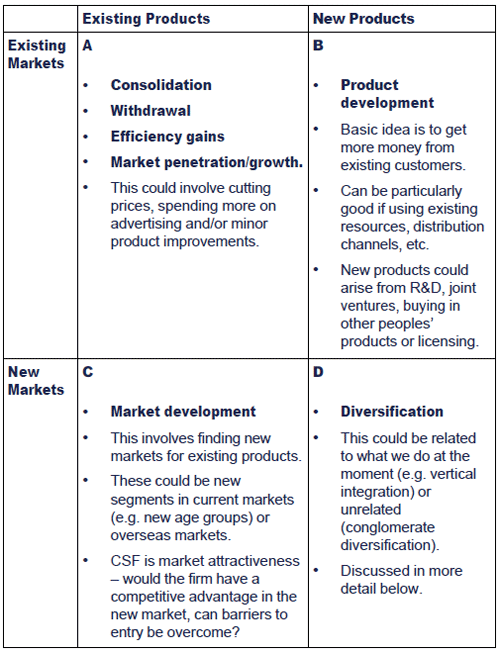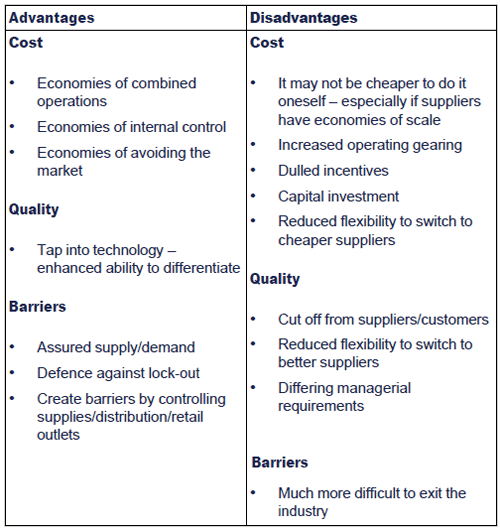Ansoff's matrix
Ansoff's matrix is a very useful tool for identifying and classifying the range of strategic options available to a firm and thus is used in the "strategic choice" part of the strategic planning process.
The matrix
Ansoff's matrix classifies strategies according to whether they involve new or existing products and new or existing markets:

Generally, risk increases from quadrant A to quadrant D (risk in quadrants B and C probably about equal).
Market penetration - existing markets and products
This is a strategy by which a company seeks to increase the sales of its present products in its existing markets. It is aimed at increased usage by methods such as recipes on tins and packets, attracting customers by offers and price reductions and by attracting new users. Note the link here with a problem child/star product in the BCG matrix.
Methods of growth might include the following.
- Build market share - particularly suitable if the overall market is growing. The business might use discounting, increased advertising, etc.
- Develop niches - target growth in a range of targeted niches within the industry, building up overall market share. This may be particularly suitable if the organisation is small compared to competitors.
- Hold market share - particularly if the market is reducing.
- Withdrawal - seek withdrawal of other companies, through, for example, using economies of scale to lower costs and make other firms uncompetitive.
The ease with which a business can pursue a policy of market penetration will depend on the nature of the market and the position of competitors. When the overall market is growing it may be easier for companies with a small market share to improve quality or productivity and increase market activity rather than in static markets, where it can be much more difficult to achieve. The lessons of the experience curve stress the difficulty of market penetration in mature markets where the cost structure of the market leaders should prevent the entry of competitors with lower market share.
Market penetration strategy would be contemplated for the following reasons.
- When the overall market is growing, or can be induced to grow, it may be relatively easy for companies entering the market, or those wishing to gain market share, to do so relatively quickly. (Some companies established in the market may be unable or unwilling to invest resources in an attempt to grow to meet the new demand.) In contrast, market penetration in static, or declining, markets can be much more difficult to achieve.
- Market penetration strategy would be forced on a company that is determined to confine its interests to its existing product/market area but is unwilling to permit a decline in sales, even though the overall market is declining.
- If other companies are leaving the market for whatever reasons, penetration could prove easy – although the good sense of the strategy may be in doubt.
- An organisation that holds a strong market position, and is able to use its experience and competences to obtain strong distinctive competitive advantages, may find it relatively easy to penetrate the market.
- A market penetration strategy requires a relatively lower level of investment with a corresponding reduction in risk and senior management involvement.
Opportunities for improving business performance within the existing pattern of trading will generally fall under the following headings.
- Advertising and promotion to increase the volume of sales into existing markets.
- Improved selling and distribution methods to improve the service offered and possibly to rationalise the market coverage.
- Modifications to products or to packaging in order to improve and broaden their appeal, and ideally to reduce costs. Some rationalisation of products may be involved.
- Improvements in productivity to make a greater volume of products available without a disproportionate increase in costs. This may involve the modification or rationalisation of production methods.
- Changes in selling price, which can be increased if the market is relatively inflexible, or reduced in order to achieve a proportionately higher volume of sales.
Even though market penetration is seen as the least risky of Ansoff's options, it should not be assumed that risk is always low.
When Yamaha attempted to gain share over Honda, it provoked a retaliation that left Yamaha in a worse position than before. The example should serve to remind us that Ansoff's strategies still require a competitive advantage to be effective (a point Ansoff made many times, but one that is frequently forgotten).
Product development - existing markets and new product
This strategy has the aim of increasing sales by developing products for a company's existing market. For our purposes, new-product development is a generic term that encompasses the development of innovative new products and the modification and improvement of existing products. By adopting this strategy the company could:
- develop new product features through attempting to adapt, modify, magnify, substitute, rearrange, reverse or combine existing features
- create different quality versions of the product
- develop additional models and sizes.
A company might show a preference for product development strategy for the following reasons:
- it holds a high relative share of the market, has a strong brand presence and enjoys distinctive competitive advantages in the market
- there is growth potential in the market
- the changing needs of its customers demand new products. Continuous product innovation is often the only way to prevent product obsolescence
- it needs to react to technological developments
- the company is particularly strong in R&D
- the company has a strong organisation structure based on product divisions
- for offensive or defensive motives, for example responding to competitive innovations in the market.
However, product development strategy does have its downside and there are strong reasons why it might not be appropriate for a company. For example, the process of creating a broad product line is expensive and potentially unprofitable, and it carries considerable investment risk. Empirical research reveals that companies enjoying high market share may benefit in profit terms from relatively high levels of R&D expenditure, while companies in weak market positions with high R&D expenditure fare badly.
There are reasons why new-product development is becoming increasingly difficult to achieve:
- in some industries there is a shortage of new product ideas
- increasing market differentiation causes market segments to narrow with the effect that low volumes reduce profit potential that in turn increases the risk of the investment involved
- a company typically has to develop many product ideas in order to produce one good one. This makes new product development very costly
- even when a product is successful it might still suffer a short life cycle with rivals quick to 'copycat' in the market but with their own innovations and improvements
- there is a high chance of product failure.
Success frequently depends upon stretching a brand further than the market is willing to take it.
Market development - existing products and new markets
Market development strategy has the aim of increasing sales by repositioning present products to new markets. (Note: this strategy is also referred to as 'market creation'.)
Kotler suggests that there are two possibilities:
(a)the company can open additional geographical markets through regional, national or international expansion
(b)the company can try to attract other market segments through developing product versions that appeal to these segments, entering new channels of distribution, or advertising in other media.
For example,
- During 1992 Kellogg undertook a major television and promotion campaign to reposition Kellogg's Cornflakes (traditionally regarded as a breakfast cereal) to provide afternoon and evening meals.
- In the same way, the malt drink Horlicks had previously repositioned from a once-a-day product ('a night meal') to become a through-the-day 'relaxing drink' for young professionals. This was not successful.
- On the other hand, Lucozade has successfully moved its brand from a product associated with infirmity to a sports-related product.
Market development strategy would be contemplated for the following reasons:
(a)the company identifies potential opportunities for market development including the possibilities of repositioning, exploiting new uses for the product or spreading into new geographical areas
(b)the company's resources are structured to produce a particular product or product line and it wouldbe very costly to switch technologies
 the company's distinctive competence lies with the product and it also has strong marketing competence (Coca-Cola provides a good example of a company that pursues market development strategies, as does the fast-food restaurant chain of McDonalds.)
the company's distinctive competence lies with the product and it also has strong marketing competence (Coca-Cola provides a good example of a company that pursues market development strategies, as does the fast-food restaurant chain of McDonalds.)
Diversification - new products in new markets
Related diversification
There are two types of related diversification:
- vertical integration
- horizontal diversification (sometimes known as concentric diversification).
Vertical integration
Taking over a supplier (backwards vertical integration) or customer (forwards vertical integration).

Horizontal diversification
Horizontal diversification refers to development into activities that are competitive with, or directly complementary to, a company's present activities. There are three cases.
(a)Competitive products. Taking over a competitor can have obvious benefits, leading eventually towards achieving a monopoly. Apart from active competition, a competitor may offer advantages such as completing geographical coverage.
(b)Complementary products. For example, a manufacturer of household vacuum cleaners could make commercial cleaners. A full product range can be presented to the market and there may well be benefits to be reaped from having many of the components common between the different ranges.
 By-products. For example, a butter manufacturer discovering increased demand for skimmed milk. Generally, income from by-products is a windfall: any you get is counted, at least initially, as a bonus.
By-products. For example, a butter manufacturer discovering increased demand for skimmed milk. Generally, income from by-products is a windfall: any you get is counted, at least initially, as a bonus.
Unrelated / conglomerate diversification
- Diversifying into completely unrelated businesses.
- Not clear where added value comes from - except if an ailing business is turned round.
- Often leads to loss of shareholder value.
Conglomerate diversification

|
Created at 10/11/2012 10:25 AM by System Account
(GMT) Greenwich Mean Time : Dublin, Edinburgh, Lisbon, London
|
Last modified at 11/1/2016 4:18 PM by System Account
(GMT) Greenwich Mean Time : Dublin, Edinburgh, Lisbon, London
|
|
|
|
 |
Rating
:
|
 Ratings & Comments
(Click the stars to rate the page) Ratings & Comments
(Click the stars to rate the page)
|
 |
Tags:
|
|
|
|
|